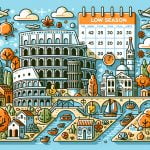Italy is a country renowned for its rich history, stunning architecture, delicious cuisine, and breathtaking landscapes. With so much to offer, it’s no wonder that Italy is a top travel destination for people from all over the world. When is the best travel season to Italy? This question can be answered by exploring the different seasons in this beautiful country and considering what each has to offer.
Each season in Italy brings its own unique charm and attractions, making it a wonderful year-round destination for travelers. Whether you’re interested in soaking up the Mediterranean sun on the Italian coast, exploring ancient ruins and historical landmarks, or indulging in world-class art and culture, there’s something for everyone in Italy.
In this article, we will take a closer look at each season in Italy – spring, summer, fall, and winter – to help you determine the best time to visit based on your interests and preferences. From the picturesque landscapes of Tuscany to the sun-drenched beaches of Sicily, you’ll discover the top destinations to visit in Italy during each season.
Plus, we’ll provide tips for choosing the best travel season for your trip to Italy so you can make the most of your unforgettable experience in this captivating country. Let’s dive into the magic of Italy and find out when is truly the best time to explore this remarkable destination.
Overview of the Four Seasons in Italy
Italy is a popular travel destination known for its rich history, stunning architecture, delicious cuisine, and beautiful landscapes. Whether you’re interested in exploring ancient ruins, relaxing on the beach, or indulging in world-class shopping and dining, Italy has something to offer every type of traveler. One of the key factors to consider when planning a trip to Italy is the best travel season to visit this iconic country.
Spring in Italy
One of the best times to visit Italy is during the spring months of April and May. During this time, the weather is mild and comfortable, making it perfect for sightseeing and outdoor activities. The countryside comes alive with colorful flowers, and the cities are bustling with festivals and events. Spring is also an ideal time to visit popular attractions like the Colosseum in Rome or the canals of Venice without having to contend with large crowds.
Summer in Italy
The summer months of June through August are peak tourist season in Italy. The weather is hot and sunny, making it an ideal time for beach vacations along the Amalfi Coast or Sicily. However, it’s important to note that many popular destinations can be overcrowded during this time, driving up prices for accommodations and making it difficult to secure reservations at top restaurants.
Fall in Italy
Fall is another fantastic time to visit Italy, particularly during the months of September and October. The temperatures begin to cool down, but the weather remains pleasant enough for outdoor activities. This is also harvest season in Italy, so visitors can enjoy wine tastings in Tuscany or truffle hunting in Piedmont.
When considering the best travel season to visit Italy, it’s essential to weigh the pros and cons of each season carefully before making your decision. Each time of year offers unique opportunities for exploration and enjoyment, so finding the perfect travel season ultimately depends on your personal preferences and travel goals.
The Best Travel Season
Spring in Italy is truly a magical time to visit this beautiful country. The weather is mild, the landscapes are blooming with colorful flowers, and there’s a sense of rejuvenation in the air. From March to June, Italy experiences ideal weather conditions that make it the perfect season for travelers to explore all that this stunning destination has to offer.
Weather and Events
During the spring months, Italy enjoys mild temperatures ranging from 55°F to 70°F (13°C to 21°C) on average. This makes it comfortable for outdoor activities such as sightseeing, hiking, and enjoying al fresco dining. Additionally, various festivals and events take place across the country during this time, giving visitors the opportunity to immerse themselves in Italian culture and traditions.
Less Crowds and Lower Prices
One of the advantages of traveling to Italy in spring is that you can avoid the large crowds that flock to popular tourist destinations during the summer months. With fewer tourists around, you’ll have more intimate experiences at historical sites, museums, and local attractions. Additionally, accommodation and flight prices tend to be more budget-friendly compared to peak tourist seasons.
Top Destinations in Spring
Some of the must-visit destinations in Italy during spring include Rome, Florence, Venice, the Amalfi Coast, Tuscany, Sicily, and the Italian Riviera. Each region offers its own unique charm and attractions that are particularly delightful during this time of year.
By Choosing Spring as Your Travel Season to Italy,
You’ll Have the Chance to Enjoy Pleasant Weather,
Festivities,cultural Experiences ,And More Without
Having to Navigate Through Throngs of Tourists Or
breaking the bank with expensive travel costs.
The Best Travel Season
Summer in Italy is a popular choice for many travelers due to the warm weather, longer days, and numerous events and festivals happening throughout the country. The summer season in Italy typically runs from June to August, with temperatures ranging from 75°F to 95°F. This makes it an ideal time for outdoor activities such as beach trips, hiking, and sightseeing without the hindrance of rain or cold weather.
One of the major highlights of traveling to Italy during the summer is getting to experience the vibrant and lively atmosphere that comes with the various festivals and events held across the country. From the historic Palio di Siena horse race in Tuscany to the famous opera performances at Verona Arena, there are plenty of cultural and entertainment experiences to indulge in during this time.
On the downside, summer is also when tourism peaks in Italy, especially in popular tourist destinations such as Rome, Florence, and Venice. This means larger crowds at popular attractions and higher prices for accommodations. Additionally, some areas can become uncomfortably hot during peak summer months, so it’s important to plan accordingly and stay hydrated when exploring outdoor attractions.
Overall, despite some drawbacks, summer remains one of the best travel seasons to visit Italy for those looking to soak up its rich culture, diverse landscapes, and sunny weather.
| Pros | Cons |
|---|---|
| Warm weather ideal for outdoor activities | Larger tourist crowds |
| Many festivals and events | Higher prices for accommodations |
| Longer days for sightseeing | Potential hot temperatures in some areas |
The Best Travel Season
Fall, or autumn, is a fantastic time to visit Italy for various reasons. The weather during this season is usually mild and pleasant, making it an ideal time for sightseeing and outdoor activities. In addition, the fall season brings with it beautiful foliage and harvest festivals, adding a special charm to the Italian landscape.
One of the main highlights of visiting Italy in the fall is experiencing the grape harvest and wine festivals. Many regions across the country celebrate this time of year with wine tastings, food events, and cultural festivities centered around grape picking and winemaking. For wine enthusiasts, visiting Tuscany or Piedmont during this season is a must-do.
The fall season is also less crowded compared to the summer months, allowing travelers to explore popular attractions without dealing with large crowds of tourists. Additionally, hotel rates tend to be more affordable during this time, making it a budget-friendly option for those looking to visit Italy. Overall, fall in Italy offers the perfect combination of favorable weather, cultural events, and fewer crowds, making it one of the best times to visit this stunning country.
| Pros | Cons |
|---|---|
| Mild & Pleasant Weather | Potential for Rainfall |
| Beautiful Foliage & Harvest Festivals | Shorter Daylight Hours |
| Less Crowded Attractions | Limited Availability in Rural Areas |
The Best Travel Season
Winter in Italy is a magical time to visit this beautiful country. While some may shy away from traveling during the winter months, Italy offers a unique and serene experience during this season. From festive holiday celebrations to stunning snow-capped landscapes, there are plenty of reasons to consider visiting Italy in the winter.
Here are a few reasons why winter is the best travel season to visit Italy:
- Festive Atmosphere: During the winter months, Italy comes alive with festive celebrations such as Christmas markets, New Year’s Eve fireworks, and Epiphany parades. The streets are adorned with twinkling lights and decorations, creating a magical atmosphere that is sure to enchant visitors.
- Fewer Tourists: Unlike the peak summer months, winter sees fewer tourists crowding popular attractions and landmarks. This means shorter lines, fewer crowds, and more opportunities to explore Italy’s iconic sites without feeling overwhelmed.
- Winter Sports: Those who enjoy skiing or snowboarding will find plenty of opportunities for winter sports in Italy. The Italian Alps offer world-class ski resorts with breathtaking alpine scenery and challenging slopes for all skill levels.
While there are many advantages to traveling to Italy in the winter, there are also some downsides to consider. It’s important to be prepared for colder weather and shorter daylight hours. Additionally, some attractions and businesses may have limited hours or closures during the off-season. However, for those who don’t mind bundling up and want to experience a quieter side of Italy, winter can be an ideal time to visit.
Pros and Cons of Traveling in Each Season
When it comes to planning a trip to Italy, one of the most important factors to consider is the best travel season. Each season offers its own unique experiences and attractions, so it’s essential to weigh the pros and cons of traveling during different times of the year.
During the spring months, from April to June, Italy showcases its picturesque landscapes with blooming flowers and mild temperatures. Travelers can take advantage of outdoor activities such as hiking, wine tasting in the countryside, and visiting historic gardens. However, spring also brings with it unpredictable rain showers and larger crowds of tourists, especially in popular cities like Rome and Florence.
Summer in Italy, from July to August, is synonymous with long sunny days, beach getaways, and vibrant festivals. It’s the perfect time for indulging in gelato while exploring coastal towns or lounging by the Mediterranean Sea. On the downside, summer also means scorching temperatures and peak tourist season, leading to higher prices for accommodations and longer lines at popular attractions.
In contrast, fall (September to November) lures travelers with cooler weather, wine harvests, and colorful foliage. This is an ideal time for food enthusiasts to savor seasonal delights like truffles and porcini mushrooms. However, some tourist sites may have reduced hours or closures during this shoulder season period. Additionally, travelers should be prepared for occasional rainy days when exploring Italy in the fall.
Top Destinations to Visit in Italy During Each Season
Italy is a country filled with an abundance of breathtaking destinations that cater to every type of traveler, and each season offers its own unique charm. Whether you’re drawn to the historical sites, stunning beaches, picturesque countryside, or delicious cuisine, Italy has something to offer year-round.
During the spring season, one of the top destinations to visit in Italy is the enchanting city of Florence. With pleasant weather and blooming gardens, this is the perfect time to explore its iconic landmarks such as the Florence Cathedral, Uffizi Gallery, and Ponte Vecchio. Additionally, the Amalfi Coast is another must-visit destination during spring. The coastal towns come alive with vibrant flowers, and you can enjoy leisurely walks along the cliffside paths overlooking the sparkling Mediterranean Sea.
As summer rolls around and temperatures soar, many travelers flock to Italy’s beautiful coastal regions such as Cinque Terre. The colorful villages perched on rugged cliffs provide a stunning backdrop for sunbathing and enjoying authentic Italian cuisine. In addition, Venice becomes a popular destination despite the crowds as visitors are drawn to its romantic canals and historic architecture.
Come fall time, Tuscany emerges as one of the top destinations in Italy with its golden sunflower fields and vineyards ripe for harvest. Cities like Rome also shine during autumn with cooler temperatures making it ideal for exploring ancient ruins such as the Colosseum and Roman Forum without swarms of tourists.
Lastly, winter brings a unique charm to cities like Milan with its stunning Christmas markets and festive decorations. For those seeking outdoor adventures, skiing in the Italian Alps is a popular choice during this season.
Overall, no matter when you choose to visit Italy throughout the year, there’s always something spectacular waiting to be discovered.
Tips for Choosing the Best Travel Season for Your Trip to Italy
When planning a trip to Italy, it’s important to consider the best travel season to ensure an enjoyable and memorable experience. With each season offering its own unique charm and attractions, there are several factors to take into account when deciding when to visit this beautiful country.
First and foremost, it’s essential to consider your personal preferences and interests. If you enjoy warm weather and vibrant outdoor activities, then the summer season may be the best time for you to visit Italy. On the other hand, if you prefer milder temperatures, picturesque fall foliage, and fewer crowds, then consider visiting during the autumn months.
Another crucial factor to consider is the peak tourist season. Summer in Italy tends to be the busiest time of year, with popular tourist destinations being crowded and accommodation prices being at their highest.
If you prefer a more relaxed and authentic experience, you may want to consider visiting during the shoulder seasons of spring or fall when the crowds are smaller and prices are more reasonable. Additionally, certain attractions and accommodations may have limited availability during the winter months in some regions of Italy.
Lastly, take into consideration any specific events or festivals that may be of interest to you. Italy hosts numerous cultural events throughout the year including Carnivale in Venice, Easter celebrations in Rome, and wine festivals in Tuscany. By researching these events ahead of time, you can plan your trip around them for a more enriching experience.
Ultimately, there is no one-size-fits-all answer to when is the best travel season to Italy as it largely depends on individual preferences and priorities. By carefully considering these tips for choosing the best travel season for your trip to Italy, you can ensure a truly unforgettable experience in this captivating country.
Conclusion
Italy is a country with a rich history, stunning landscapes, and delicious cuisine, making it a popular travel destination for people all over the world. However, choosing the best time to visit Italy can be a tough decision. After evaluating the four seasons in Italy and the pros and cons of traveling during each one, it can be concluded that the best travel season to visit Italy is during the spring.
Spring in Italy offers comfortable temperatures, blooming flowers, and less crowded attractions compared to the summer months. Although summer is also a great time to visit, it can get extremely hot and crowded with tourists. On the other hand, fall brings beautiful foliage and cooler temperatures but can also bring some rain. Winter offers smaller crowds and festive holiday markets, but some attractions may be closed or have limited hours.
No matter which season you choose to visit Italy, there are plenty of top destinations to explore throughout the country. From the bustling streets of Rome to the romantic canals of Venice, there is something for everyone in Italy no matter when you decide to visit.
Whether you’re interested in historical sites, stunning coastlines, or charming countryside villages, Italy has it all. Ultimately, planning your trip around your preferences and prioritizing what you want to see and do will help you determine the best time for you to visit Italy.
Frequently Asked Questions
Which Month Is Best to Visit Italy?
The best month to visit Italy really depends on what you want to experience. If you prefer milder weather and fewer crowds, then consider visiting in May or September. These months offer pleasant temperatures and less tourist congestion compared to the summer months.
What Is the Cheapest Time to Go to Italy?
Generally, the cheapest time to go to Italy is during the winter months, specifically January and February. During this time, airfare and accommodation prices tend to be lower due to it being the off-peak travel season. However, do keep in mind that some attractions and restaurants may have reduced hours or even be closed during this time.
What Is Peak Tourist Season in Italy?
Peak tourist season in Italy typically occurs during the summer months of June to August. During this time, popular tourist destinations are crowded with visitors from all over the world, which can result in long lines at attractions and higher accommodation prices.
If you prefer a quieter travel experience, it’s best to avoid these months and opt for shoulder seasons instead.

I’m a passionate traveler, writer, and Italophile. My fascination with Italy’s history, art, and culture has led me on countless adventures across the Italian landscape. Through “I Live Italy,” I share my love for this extraordinary country and aims to inspire others to explore its boundless beauty.




